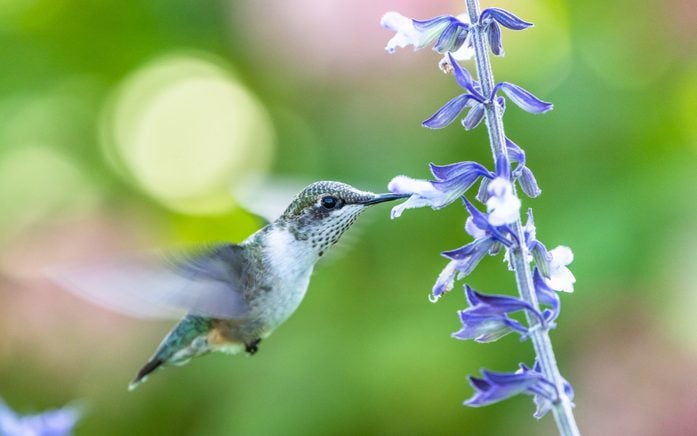
Grow Salvias for Hummingbirds
Salvias are an incredibly diverse group—an option exists for every ecosystem. Native varieties provide the most nectar for visiting hummingbirds, but hummers will also sip from cultivars, which come in a wider range of colors and sizes. A hummingbird’s long tongue, which can extend to about twice the length of its bill, is perfectly adapted to salvia’s long tubular flowers. If you want to see more of these tiny fliers, grow these salvias for hummingbirds. Plant an array of hues, shapes and forms for wildlife to enjoy throughout the season and to make your garden a hive of activity.
Check out the best perennials to grow for hummingbirds.
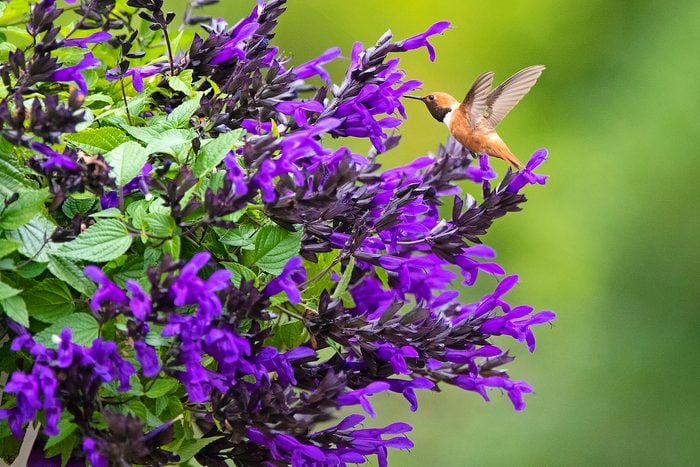
Hummingbird Falls Bodacious Salvia
Salvia x guaranitica, Zones 7 to 8 or Annual
Bodacious is one of the best salvias for hanging baskets. Its draping quality makes it a perfect spiller or ground cover. It reaches 2 feet tall while spreading up to 3 feet wide. The blossoms appear in spring and bloom continuously through fall in full sun to part shade. Use as an annual in cool climates.
Why we love it: You’ll easily spot visiting hummingbirds when this salvia is hung at eye level.
We found the top 15 colorful hummingbird flowers to grow.
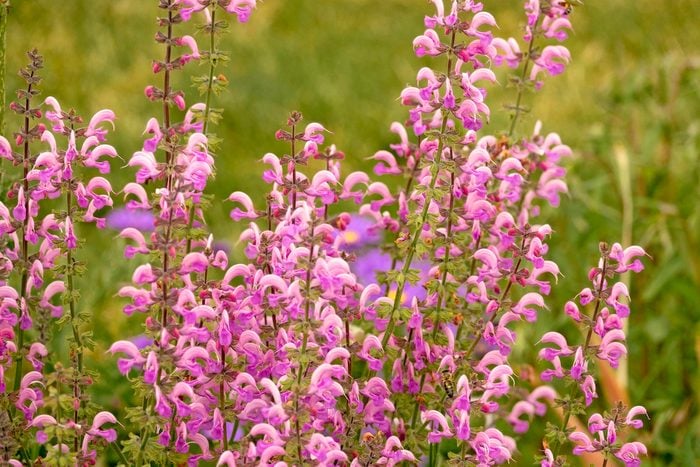
Rose Rhapsody Ballet Meadow Sage
Salvia pratensis, Zones 3 to 9
The soft pink blooms have a hooded appearance and make wonderful cut flowers. Rose Rhapsody welcomes deadheading in spring and can be easily divided to plant elsewhere in the garden. Grow in a spot with consistent moisture for best results. It has an upright form and attracts hummingbirds and bees, while also being deer resistant.
Why we love it: The plant tolerates heat and humidity as well as a range of soils.
To see more pretty pollinators, add a bird bath for hummingbirds to your yard.
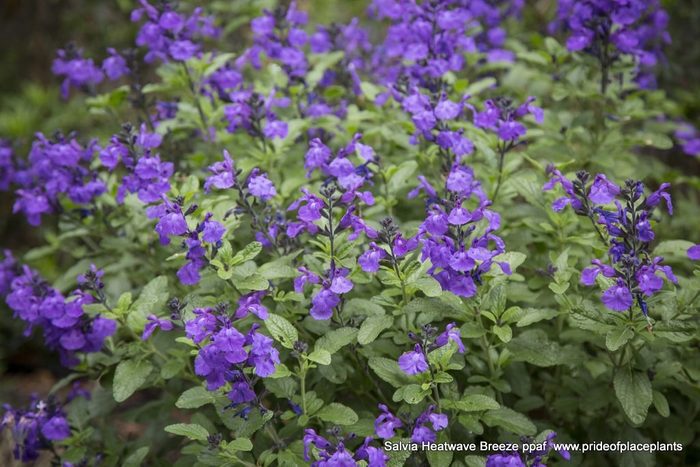
Heatwave Breeze Salvia
Salvia microphylla x greggii, Zones 6 to 10 or Annual
This cultivar has an upright and rounded habit that reaches a height and width of 2 to 3 feet. The rich purple blooms welcome hummingbirds with their large tubular shape. After the first flush of blooms, trim the plant back to encourage even more flowers.
Why we love it: Developed as a water-wise plant, Breeze needs well-draining soil and tolerates drought.
Check out these popular annuals that attract hummingbirds.
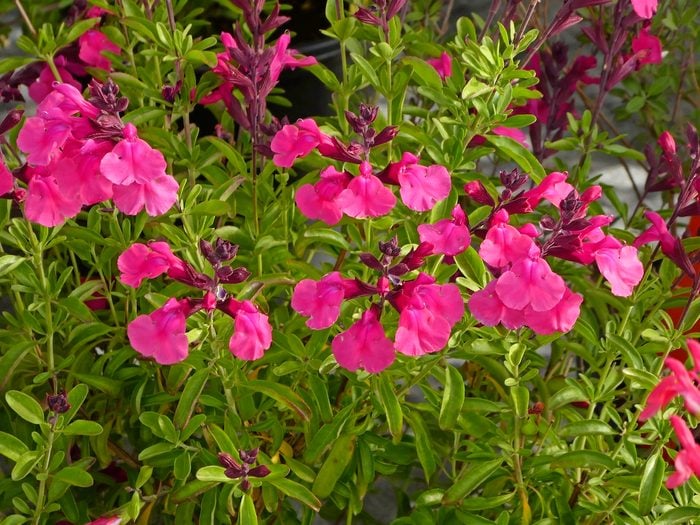
Cold Hardy Pink Bush Sage
Salvia greggii, Zones 6 to 10
Bred from a Texas native, Cold Hardy Pink sage is ideal in a border or container. The rosy pink bloomer invites all sorts of pollinators. It grows in most of the United States, but thrives in the Southwest.
Why we love it: Small-space gardeners will appreciate its compact size—the plant tops out at around 20 inches.
Psst—Hummingbirds will flock to a hummingbird mint plant.
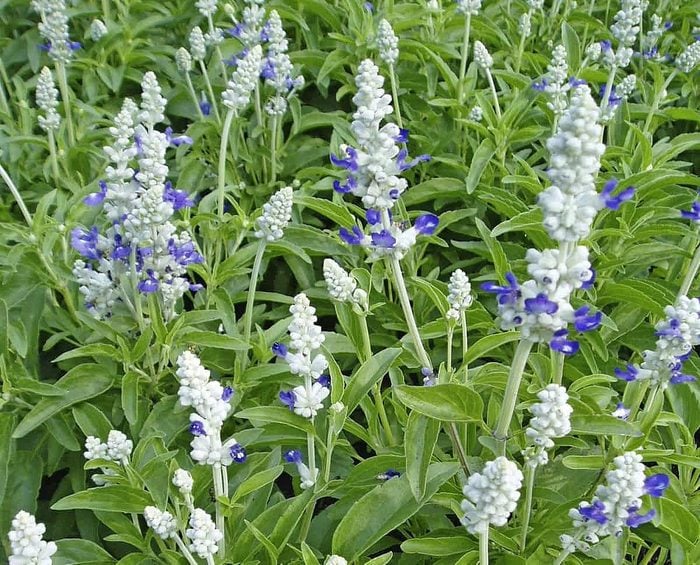
Strata Mealycup Sage
Salvia farinacea, Zones 8 to 11
Bicolor blue and white flowers lend additional interest to this award-winning mealycup sage. It stands at 2 feet tall and tolerates heavy rain, heat or drought. The green foliage and blue petals on these salvias for hummingbirds add gorgeous cool tones to summer gardens.
Why we love it: In a sunny border, Strata blooms continuously and is mostly pest-free. Cut flowers can be easily dried for arrangements.
Add more color with the top 10 vines for hummingbirds.
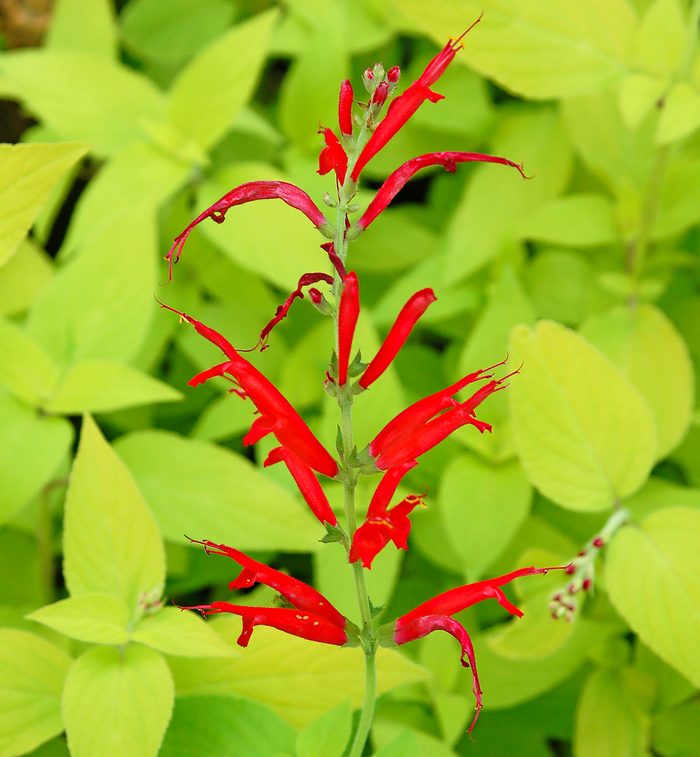
Rockin’ Golden Delicious Golden Leaved Pineapple Sage
Salvia elegans, Zones 8 to 11 or Annual
For most gardeners, this salvia stands out for its vibrant yellow-green foliage. In areas with a long growing season, the plant also produces fire-engine red flowers in fall, attracting butterflies and hummers.
Why we love it: Pineapple sage’s blooms are lusciously fragrant—and edible. Use them in salads and garnishes.
Amaze your friends with these jaw-dropping hummingbird facts.
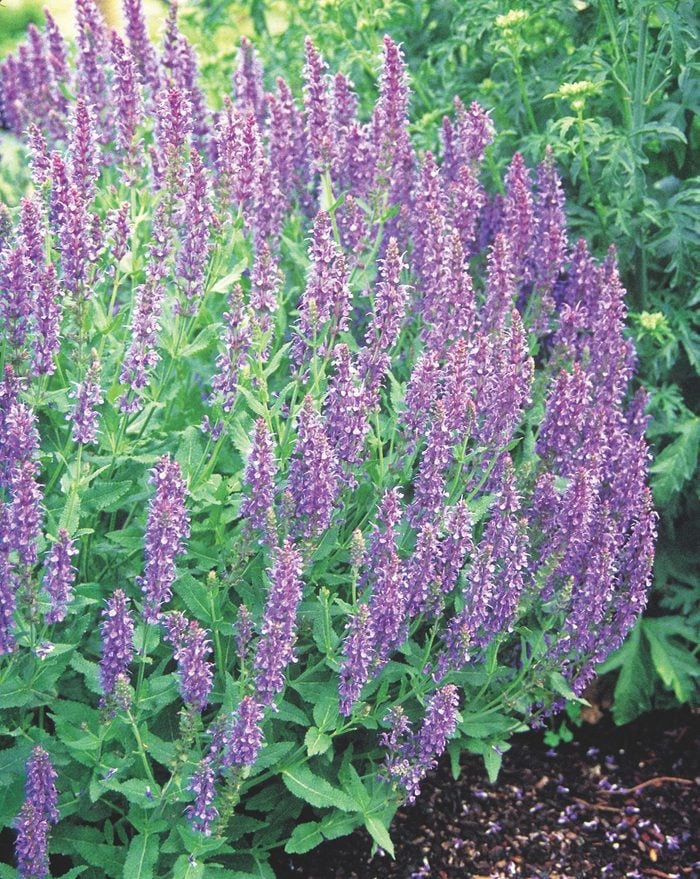
Blue Hill Meadow Sage
Salvia x sylvestris, Zones 4 to 8
Blue Hill is a compact salvia that’s best planted in containers, at the edge of a border or as a taller ground cover in full sun. This variety is salt tolerant, so try planting these salvias for hummingbirds along driveways or sidewalks. The deep violet blooms persist from early summer through fall with deadheading. It prefers drier soil in winter and moist to moderately moist soils in the summer.
Why we love it: It produces beautiful cut flowers, and it resists rabbits and deer, too.
Grow Mexican bush sage for butterflies and hummingbirds.
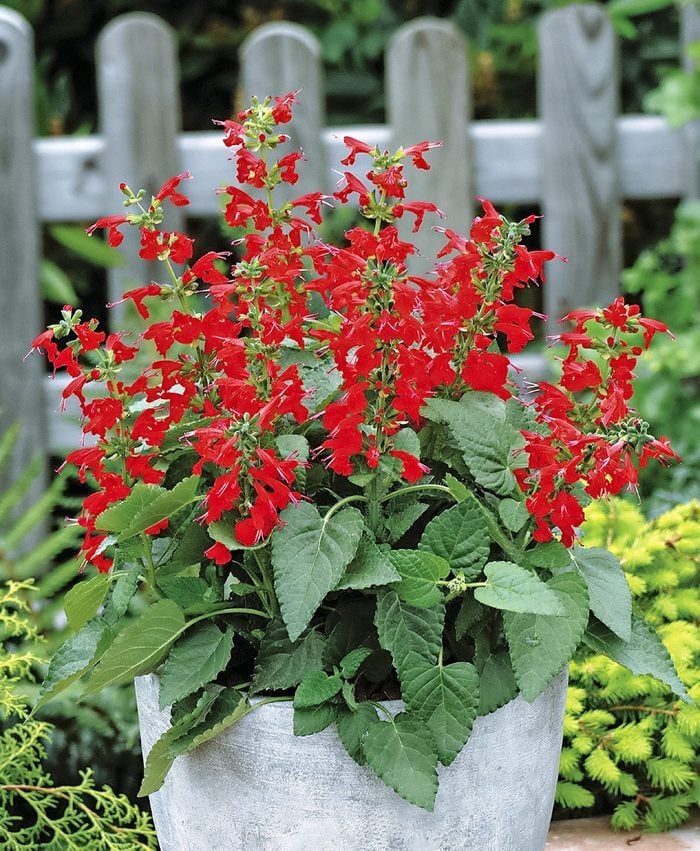
Lady in Red Dwarf Scarlet Salvia
Salvia coccinea, Zones 8 to 10 or Annual
Chosen for its high performance, dwarf size and early flowers, this plant is an All-America Selections winner. It grows 12 to 14 inches tall, with brilliant red blooms from May into November—it can even handle a light frost.
Why we love it: The warm colors are like beacons to hummingbirds on the move during migration.
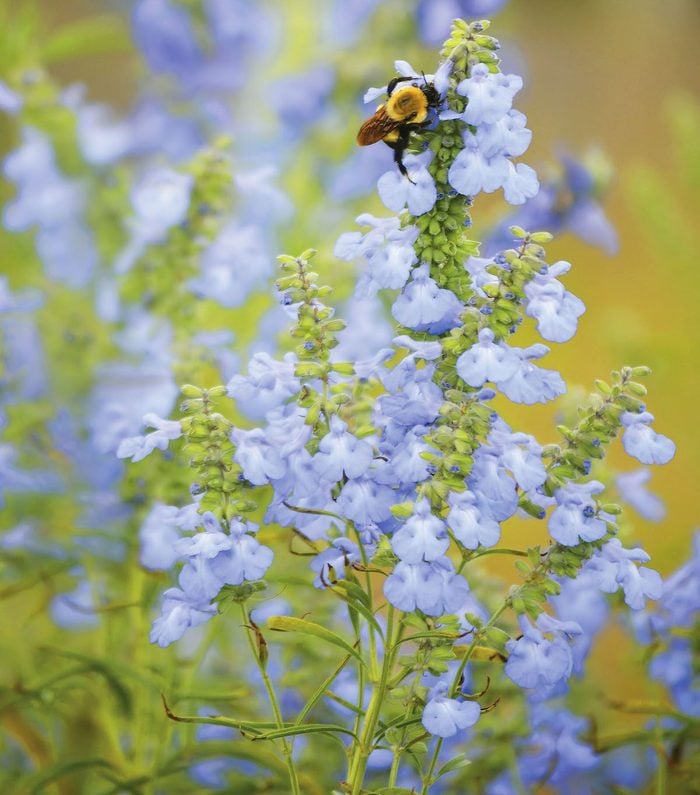
Pitcher Sage
Salvia azurea var. grandiflora, Zones 5 to 9
This perennial is cold hardy up to Zone 5 and comes in a range of blue hues as well as white. It looks great planted by tall grasses in a meadow or as a shrubby border. Cut back the plant’s fragrant stems in late spring to keep it more compact and to promote new blooms.
Why we love it: A giant in the salvia world, it can reach 3 to 5 feet in height and grows nearly as wide.
We asked the experts: Will hummingbirds use a birdhouse?
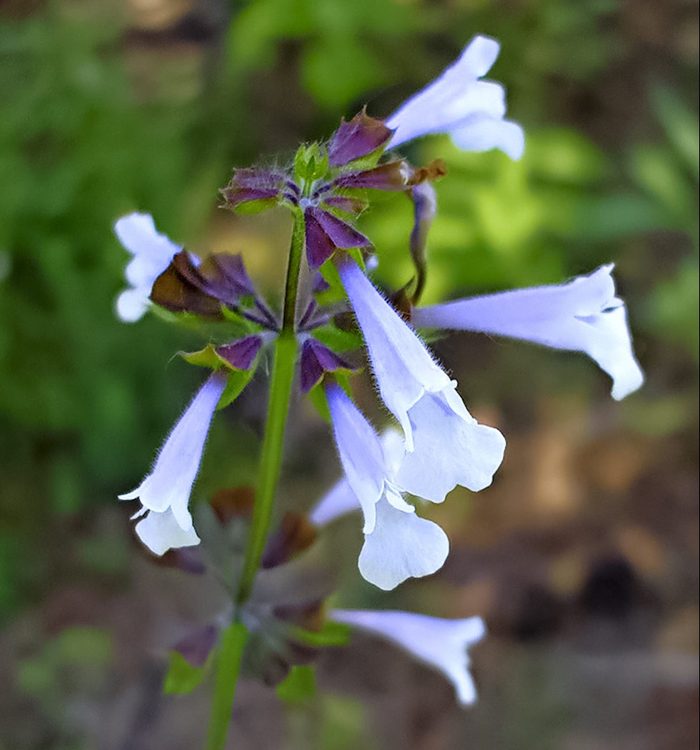
Lyreleaf Sage
Salvia lyrata, Zones 5 to 8
This sage stands between 1 and 2 feet tall. In the winter, a purple-green rosette of leaves marks its place in the garden. It blooms in full sun from April through June with blue, violet or white flowers. It’s ideal in rain gardens and tolerates some flooding.
Why we love it: Use it as a ground cover after it blooms—you can even mow the plants for a tidier look.
Next, check out the best hummingbird feeders, supplies and accessories.
